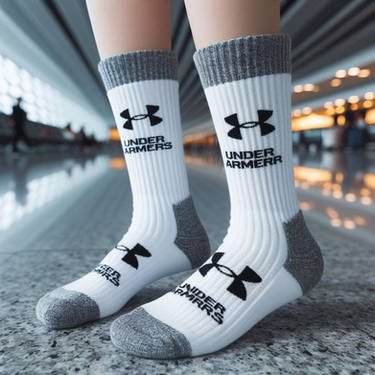Last Updated on December 17, 2024 by Rida Gul
Swelling can be a common issue for many individuals, whether due to standing for long periods, traveling, pregnancy, or underlying medical conditions. Compression socks are a proven solution to help reduce swelling, promote circulation, and improve overall leg health. Some of the best compression socks for swelling are Levsox, Bluemaple Copper, Bombay compression socks, and many more. Let’s dive into the content for a detailed outlook.
Table of Contents
What Are Compression Socks?
Compression socks are specialized hosiery designed to improve blood flow in the legs. They exert gentle pressure on your legs and ankles, helping to reduce swelling, prevent blood clots, and alleviate discomfort caused by poor circulation. Compression socks are often recommended for individuals with medical conditions like varicose veins, deep vein thrombosis (DVT), and lymphedema. They are also popular among athletes and travelers.
Factors to Consider When Choosing Compression Socks
Levels of Compression
Compression socks range from mild to extra firm:
- Mild to Firm (10-30 mmHg): Ideal for everyday use, travel, sports, and mild varicose veins. These are typically sold over the counter.
- Extra Firm (Up to 50 mmHg or more): Recommended for serious conditions like blood clots, post-surgery recovery, or severe varicose veins. These may require a prescription.
Comfort and Fit
Compression socks should feel snug but comfortable. If you experience pain, numbness, or tingling, they may be too tight. Look for features like breathable fabrics, seamless toes, and various lengths (ankle to waist-high) to ensure maximum comfort.
Style Options
Compression socks come in various lengths, colors, and styles, from sheer and lightweight to more opaque and durable designs. Consider the setting in which you’ll wear them—work, travel, or exercise.
Special Uses
For medical issues, such as preventing blood clots after surgery, seek anti-embolism stockings instead of regular compression socks. Consult with your doctor to determine the best type and fit, especially for prescription-grade options.
Price Considerations
While compression socks may be pricier than regular socks, there are budget-friendly options available. Investing in the right pair can significantly improve comfort and reduce swelling.
Best Compression Socks for Swelling
Levsox Compression Socks
The LEVSOX 20-30mmHg Compression Socks for Women and Men will fit well, feel comfortable, and provide the correct amount of support. These socks are made with a blend of nylon and spandex, offering durability and breathability while remaining comfortable for all-day wear.
- Compression Level: 20-30 mmHg
- Material: 90% nylon, 10% spandex
- Available Sizes: S – XL
Charmking Compression Socks
Charmking socks are available in multi-packs and a wide range of styles, from plain designs to colorful patterns. Their blend of nylon and spandex ensures a snug but comfortable fit. The only area where they underperformed compared to other pairs is how they felt. Due to their nylon composition, they cause a little sweat.
- Compression Level: 15-20 mmHg
- Material: 85% nylon, 15% spandex
- Available Sizes: S/M and L/XL
Bluemaple Copper Compression Socks
Bluemaple Copper Compression Socks combine the benefits of compression with copper-infused fibers for enhanced performance. The copper fibers also have antimicrobial properties, helping reduce odors and keep feet fresh. These socks are also quite supportive; the difference in how our legs felt while wearing them versus not wearing them was evident, with the socks easing end-of-day heaviness and tiredness. Overall, the Bluemaple socks are an excellent, versatile choice for pregnancy.
- Compression Level: 20-30 mmHg
- Material: 85% nylon, 15% polyester
- Available Sizes: S/M and L/XL
Bombas Everyday Compression Socks
Bombas Everyday Compression Socks are shorter in size and allow you to avoid that squeezed feeling around the knees. They continue to offer whole-calf compression and stay in place. Known for their comfort, Bombas socks feature a seamless toe and cushioned footbed, ensuring an irritation-free experience.
Compression level: 15 to 20 mm Hg
Material: 67% to 69% Supima cotton, 17% polyester, 9% to 10% elastane, 5% to 6% nylon
VIM & VIGR Stylish Compression Socks
VIM & VIGR Stylish Compression Socks are a perfect combination of fashion and function. Made from high-quality materials like cotton, nylon, and wool, VIM & VIGR socks are soft and breathable, ensuring comfort throughout the day.
Compression levels: medium (15 to 20 mm Hg), hard (20 to 30 mm Hg), and extremely firm (30 to 40 mm Hg), usually prescribed by a physician.
Sizes available: S/M, M/L, and L/XL
Materials: 91% nylon, 9% spandex
Benefits of Compression Socks for Swelling
Compression socks provide several benefits:
- Helps push blood back to the heart, preventing fluid pooling in the legs.
- Limits fluid buildup in tissues, reducing swelling in feet, ankles, and legs.
- Eases discomfort by reducing inflammation and promoting better blood flow.
- Helps prevent deep vein thrombosis (DVT), especially during long periods of inactivity.
- Boosts performance and reduces muscle fatigue for athletes.
How Do Compression Socks Work?
Wearing compression socks helps to reduce fluid buildup in your lower legs by exerting pressure on your calves and ankles. This helps to keep swelling down by allowing your blood vessels to circulate blood without forming blood clots. Furthermore, the continual pressure generated by compression socks keeps blood vessels from enlarging and blood pooling. If left untreated, both of these problems might result in weaker or varicose veins over time.
When to Wear Compression Socks
Compression socks can be worn throughout the day, but it’s crucial to put them on in the morning before swelling begins. They are especially beneficial during long periods of standing or sitting. When traveling, particularly on long flights or car rides, compression socks can reduce swelling and lower the risk of blood clots. Athletes also use them to enhance performance and minimize post-exercise swelling. Pregnant women often experience leg and ankle swelling, and compression socks can offer significant relief during pregnancy.
Tips for Compression Socks Care
Compression socks should be washed after each usage to maintain elasticity and hygiene. Wash them carefully in cool water with a moderate detergent. Fabric softeners and bleach should be avoided because they can cause fiber breakdown. Allow the socks to dry naturally away from direct heat and sunshine, and do not iron them.
Tips for First-Time Compression Socks Users
Compression socks or stockings may feel uncomfortable at first, causing your legs to ache or become sore. This is normal, and you will get used to it after a few wears. However, if you experience severe pain or your legs or feet become discolored, contact your doctor immediately. First-time users should note the following tips:
- Turn the socks inside out up to the ankle, slide your foot in, and gently roll them up your legs, ensuring the fabric is smooth to prevent snags.
- For thigh-highs or full-length socks, stand to pull them past your knees.
- Wearing rubber gloves can help you grip the socks better while putting them on.
- Avoid using lotions or oils before wearing the socks, as they make them harder to put on.
Side Effects of Wearing Compression Socks
Compression socks might cause some negative effects, especially if you don’t use them appropriately or in the wrong size. The most common side effects are:
- Skin irritation, such as itching, feeling chilly or warm
- Pain or discomfort.
- Redness
- Allergic response to the socks material.
- Bacterial or fungal infections
- Soft tissue injury.
Conclusion
A practical solution for individuals experiencing swelling is best compression socks for swelling. By improving blood flow and reducing fluid retention, these socks offer relief and help prevent more severe conditions like DVT. Whether you need mild support for daily wear or firm compression for medical reasons, the right pair of compression socks can significantly improve your leg health and overall comfort.
Apart from that if you want to know about “What makes a diabetic sock different” then please visit our “Lifestyle” Category.
FAQs
Compression socks are customized hosiery that improve blood flow in the legs. They prevent fluid buildup by promoting blood flow back to the heart.
Anyone experiencing leg swelling, standing or sitting for long periods, traveling, or recovering from surgery may benefit from compression socks. Pregnant women and athletes also frequently use them for added support.
For mild swelling or daily use, 10-20 mmHg compression socks are sufficient. For more severe swelling, varicose veins, or medical conditions, 20-30 mmHg or higher might be needed. Consult a healthcare professional for severe cases.
















